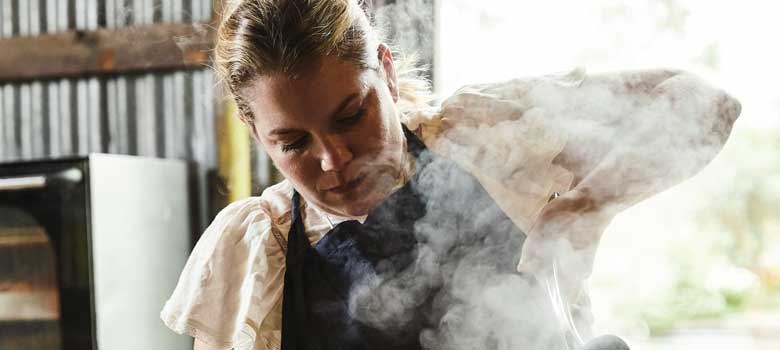
Food
Danielle Alvarez
From Simple to Wonderful
As flames lick at the back of the open hearth, a lamb leg suspended from the bone spins on a string, fat gently rendering away leaving a crisp, salted exterior. Other less-spinnable cuts are cooking in the wood-fired oven, benefiting from that same ageless love affair between meat and fire.
The central island bench is laden with bowls of peas, beans, lemons and artichokes. The perfume of fresh herbs is in the air. The Fred’s kitchen is a living still life.
The cooking at Fred’s is known for its elegant simplicity, which belies the technique behind it. At its heart is chef Danielle Alvarez, her temperament matching the gentle beauty that surrounds her, her cooking exuding the same.
That elegant simplicity has seen Fred’s Restaurant receive high acclaim from critics and the public alike since it opened in Sydney’s Paddington four years ago. I don’t think you can underestimate how hard it is to make something that simple that sublime.

Above: Danielle's Slow-roasted Lamb Shoulder with White Beans and Harissa recipe
It comes from a dedication to learning, questioning and practicing the art of cooking, the same dedication that’s seeing Danielle’s new cookbook Always Add Lemon receive similar acclaim.
“I wanted to share every detail, every note,” says Danielle. “Over the years I’ve learnt so much, I wanted to distil it to the finest detail.”
These lessons were gleaned from some of the world’s great kitchens – that lamb leg a la ficelle was first learnt at Alice Waters’s Chez Panisse in California, before that, it was Thomas Keller’s French Laundry and Amaryll Schwertner’s Boulettes Larder. Putting that knowledge into words was an honour for Alvarez.
“I adore cookbooks,” she says. “I think when you read them, you’re witnessing the bearing of someone’s soul – it’s so lovely to see someone putting their feet firmly in the ground and saying this is me.”

Above: Danielle Alvarez's Green Soup recipe
With expectations sky high, trading the wooden spoon for the pen was not without its anxiety. “It’s so different to being in the restaurant,” explains Danielle. “If I don’t like what happened yesterday, tomorrow is an opportunity to make it better, with a book you can’t do that – you’re telling people how to do it, and it is a finished product!”
With a vast library of cookbooks in her own collection – and a penchant for writers such as Elizabeth David, Richard Olney, Diana Kennedy, alongside Paul Bertolli (“his menus feel like poetry”) and Julia Ostro, her benchmark was also high.
“Interestingly, I tried not to look at too many other books while writing it as I didn’t want to even unknowingly take things. That said, I was actually surprised at the total ownership of the process – I thought someone was going to coach me, was going to tell me to add more emotion (or pull some out), but it wasn’t that way. At one point, I realised I was trying to give everything at once. I had to just say stop, kind of like cooking, I had to learn when enough was enough.”
“It’s such a vulnerable state you’re in,” Danielle continues, “I felt it for several months. And yet, I also feel it has somehow legitimised me. In one hundred recipes there is a good sense of the person I am and why I cook the way I do.”
Building blocks
Anyone who knows Danielle’s cooking will know the produce is paramount. There are few chefs who have worked so hard to forge a connection with their producers and the seasons.
All the produce used at Fred’s is seasonal, ethically reared and, consequently, has incredible flavour. This is a question of taste, place and connection, it’s about creating your own flavour memory bank, it’s about asking questions. It is from these building blocks that Danielle works her recipes.
Importantly, Danielle doesn’t shy away from the humble, the foods that made her want to start cooking in the first place.
“I wanted to know why, time and again, the simplest, humblest of ingredients ended up producing the dishes people gravitated towards. A bowl of pasta, a pot of beans or polenta bubbling away – there are great subtleties in their magic, but they seem to have universal appeal.”

Above: Danielle Alvarez's Green Pasta with Zucchini, Sage and Peas recipe
It is these subtleties you’ll learn in her book. The recipes are not so much an assembly of ingredients, but rather a series of potential decisions, it is written to take you into the mind of a chef, the sum of many parts, of many decisions. These minor details make the simple amazing.
“I look at other cookbooks and have no criticism of them – that wonderful youthful way of admiring the way they were written,” sighs Danielle. “I actually wish I felt more that way as a chef in a restaurant – I do critique things when I go out, but I feel humbled with books.”
“I still can’t believe there’s one with my name on it!” she laughs. “Happily, I’ve even been cooking from it myself – I don’t believe in perfection and rarely do things the same way twice, but here I know I can find the recipe for that thing I made that time that worked out well. It really is a collection of all the things I love.”
If you are seeking elegant simplicity in your kitchen, you will too.